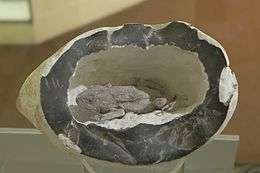Entombed animal
Entombed animals (also "toad in the hole"[1]) are animals often reportedly found alive after being encased in solid rock, or coal or wood,[2] for an indeterminate amount of time. The accounts usually involve frogs or toads. The phenomenon has been dismissed by mainstream science, but has remained a topic of interest to Fortean researchers.

Reports
References to entombed animals have appeared in the writings of William of Newburgh,[3] J. G. Wood,[4] Ambroise Paré,[5] Robert Plot,[6] André Marie Constant Duméril, John Wesley, and others.[1][7] Even Charles Dickens mentioned the phenomenon in his journal All the Year Round.[8] According to the Fortean Times, about 210 entombed animal cases have been described in Europe, North America, Africa, Australia, and New Zealand since the fifteenth century.[1]
At times, multiple animals are said to have been encased in the same place. Benjamin Franklin wrote an account of four live toads claimed to have been found enclosed in quarried limestone.[9] In a letter to Julian Huxley, one Eric G. Mackley claimed to have freed 23 frogs from a single piece of concrete while widening a road in Devonshire. An 1876 report from South Africa said that 63 small toads were found in the middle of a 16-foot-wide (5 m) tree trunk.[7]
Explanations
Though reports of entombed animals have occurred as recently as the 1980s, scientists have paid little serious attention to the phenomenon since the nineteenth century. During the 1820s, English geologist William Buckland conducted an experiment to see how long a toad could remain alive while encased in stone. He placed toads of different sizes and ages into carved chambers within limestone and sandstone blocks, then buried the blocks in his garden. A year later, he dug up the blocks and found that most of the toads were dead and decayed. A few toads that had been in the limestone (which did contain small pores) were still living. However, Buckland found them all dead after reburying them in the limestone for another year. Buckland concluded that toads could not survive inside rock for extreme lengths of time, and determined that reports of the entombed animal phenomenon were mistaken. Most scientists agreed.[10] A writer from the journal Nature wrote in 1910, "The true interpretation of these alleged occurrences appears to be simply this – a frog or toad is hopping about while a stone is being broken, and the non-scientific observer immediately rushes to the conclusion that he has seen the creature dropping out of the stone itself. One thing is certainly remarkable, that although numbers of field geologists and collectors of specimens of rocks, fossils, and minerals are hammering away all over the world, not one of these investigators has ever come upon a specimen of a live frog or toad imbedded in stone or in coal."[11]
Some of the stories may be based on outright fabrications. Charles Dawson, quite probably the perpetrator of the Piltdown Man hoax, had some years earlier presented the Brighton "Toad in the Hole" (a toad entombed within a flint nodule), likely another forgery.[12] Dawson presented the toad to the Brighton and Hove Natural History and Philosophical Society on 18 April 1901, claiming that two workmen had found the flint nodule in a quarry north-east of Lewes a couple of years earlier, which revealed a toad inside when they broke it open. The toad was eventually passed on to the Booth Museum of Natural History in Brighton via Henry Willett. However, the toad has since shrunk, suggesting that it cannot have been very old at the time of its discovery.[13][14]
In fiction
Perhaps the most famous example of a fictional entombed animal is Merrie Melodies character Michigan J. Frog, who is discovered inside the cornerstone of a building in his debut appearance, "One Froggy Evening."[15] A reference to the phenomenon also appears in Dante Gabriel Rossetti's poem "Jenny," which mentions a "toad within a stone / Seated while time crumbles on."[1] A lizard is found entombed in a rock in the film Giant from the Unknown.
Further reading
- Bondeson, Jan (1999). The Feejee Mermaid and Other Essays in Natural and Unnatural History. Ithaca, N.Y: Cornell University Press. ISBN 0-8014-3609-5.
Notes
- Jan Bondeson. "Toad in the Hole". Fortean Times. June 2007.
- Mark Pilkington. "Toads in the hole". The Guardian. January 20, 2005. Retrieved on January 9, 2009.
- William of Newburgh. Trans. Joseph Stevenson. "The History of William of Newburgh", in The Church Historians, volume IV, part II. 1856. 722.
- J. G. Wood and Harrison Weir. Sketches and Anecdotes of Animal Life. 1856. 39.
- Ambroise Paré. Trans. Janis L. Pallister. Of Monsters and Marvels. 1995. 93.
- qtd. in George Griffiths. A History of Tong, Shropshire. 1894. 192.
- Jerome Clark. "Entombed animals". Unexplained! Farmington Hills, MI: Visible Ink, 1999. 164-169.
- Charles Dickens. All the Year Round. Volume VIII. 1862-1863. 255.
- Benjamin Franklin. "An Account of Toads Found Enclosed in Solid Stone." In The Works of Benjamin Franklin, ed. Jared Sparks. Volume VI. 1882. 441–442.
- "Curiosities of Natural History". Blackwood's Edinburgh Magazine. March 1858. 360.
- "Notes". Nature 83 (1910): 406-407.
- Russell, Miles (2003). Piltdown Man: The Secret Life of Charles Dawson & the World's Greatest Archaeological Hoax. Stroud: Tempus Publishing. ISBN 0-7524-2572-2.
- Mark Jones; Paul T. Craddock; Nicolas Barker, eds. (1 July 1992). Fake?: The Art of Deception. University of California Press. p. 95. ISBN 978-0520070875.
- Miles Russell (30 May 2012). The Piltdown Man Hoax: Case Closed. The History Press. ISBN 9780752487809.
- David George Gordon. "Hibernating Hoppers: Can Toads Live Buried for Decades?" MSN Encarta. Retrieved 2 September 2007. Archived 2009-10-31.